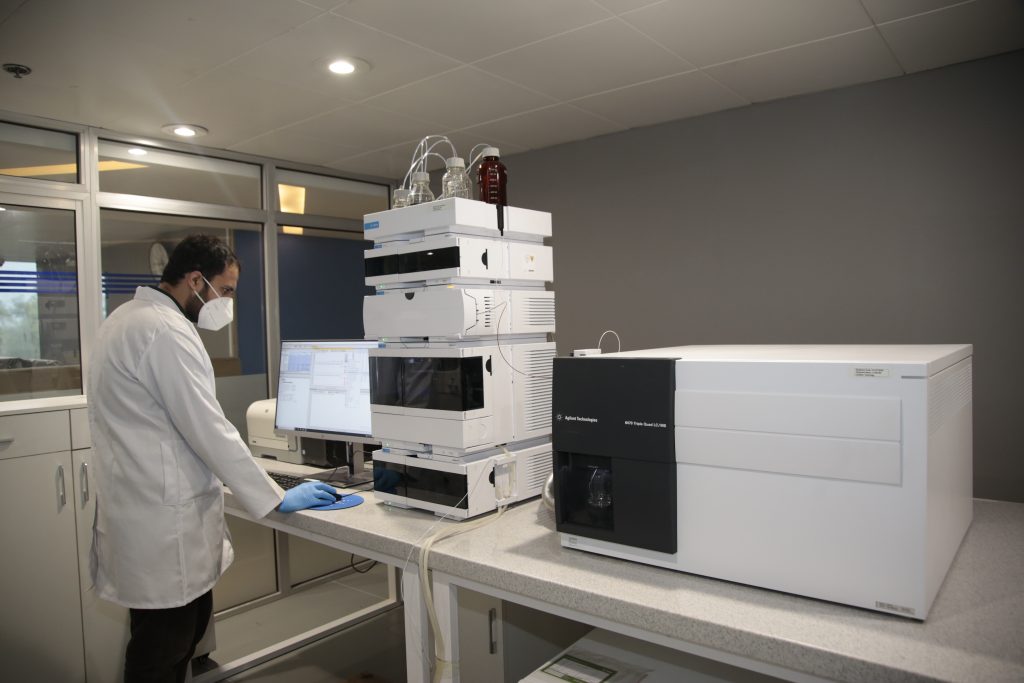
Clinical and Forensic Toxicology Department
The Clinical and Forensic Toxicology Department has been established under the umbrella of Chughtai Healthcare to provide credible and reliable services to the nation of Pakistan. This laboratory’s work is based on international toxicology guidelines and standard operating procedures and has secured accreditation from two international accreditation bodies: The College of American Pathologists (CAP) and ISO-15189. This is the only CAP-Accredited Toxicology laboratory in Pakistan.
The international standards we have adopted include:
- Witnessed specimen collection procedure (to ensure donor specimen identity)
- Consent declaration and chain of custody documentation (to ensure specimen integrity)
- State-of-the-art testing facility equipped with the latest technology like UHPLC-MS/MS, Tox-Analyzer GC-MS, Headspace GC-FID, Atomic Absorption Spectroscopy, etc.
- Specimen validity test (to discourage drug test beating by the donor and rule out specimen substitution and/or adulteration)
- Rapid urine drug screening based on the Substance Abuse and Mental Health Services Administration (SAMHSA) cut-off values
- Confirmatory tests for positive-screened samples
- Technical & Administrative review and reporting
- Interpretation of results & court testimony, on request
The addition of accurate and reliable drug testing using hair and blood specimens has complemented urine drug testing and can aid in combating organizations devoted to suborning drug testing through adulteration, substitution, and dilution. For example, hair testing may detect chronic drug exposure from weeks to years and is a useful tool in pre-admission, pre-employment, and on-the-job workplace/forensic drug testing. Our state-of-the-art instruments and validated methodologies make our tests reliable and efficient.
Currently, we are offering the following testing services:
- Urine Drugs of Abuse Screening Panel
- Targeted drugs of abuse Panel in Hair
- Targeted drugs of abuse Panel in Blood
- Qualitative Confirmation Panel 1 (Opiates, cocaine, & their metabolites) in urine, blood, or hair samples
- Qualitative confirmation of each drug class, like Cannabinoids, Benzodiazepines, Opiates/ Opioids, Cocaine, Amphetamines, Phencyclidine, etc,. in urine, blood, or hair
- پیشاب میں کینابینوائڈز (Cannabinoids) کی مقداری (Quantitative)تصدیق
- Nicotine and cotinine levels in blood or urine
- Qualitative Confirmation of Nicotine and Cotinine in Hair
- Blood Alcohol concentration
- Urine Alcohol Concentration
- Blood carbon monoxide qualitative confirmation
- Poison screening tests (Paraphenylenediamine, Cyanide, Phosphine, Arsenic, Mercury, Salicylates, Methanol, etc.)
- Serum Vitamin A test
- Serum Vitamin E test
- Serum Copper test
We are also offering research sample testing for unknown compounds, quantification of compounds, pesticide residue testing, organic volatiles impurities, etc.
ان ٹیسٹوں سے کون مسفید ہو سکتے ہیں؟
- Academic Institutions (Schools, Colleges, Universities)
- Law enforcement Agencies (Police, Lawyers, etc.)
- Civil Aviation Authorities
- Medical doctors & Medico-legal examiners
- National & Multinational companies/ organizations
- Sports bodies/ organizations
- Olympic Associations
- Rehabilitation centers
- Researchers
The toxicology department is leading & successfully running a nationwide campaign, “Drug Free Pakistan, “ to combat the menace of drug abuse in Pakistan.

FAQ’s
Blood alcohol concentration shows:
- Not intoxicated/ Sober: 0.0 mg/dL
- Intoxicated: 10.0-80.0 mg/dL
- Very impaired: Above 80 mg/dL.
- At risk for serious complications: Above 450 mg/dL. At this blood alcohol level, you may be at risk for coma or death.
The timing of this test can affect the accuracy of the results. A urine alcohol test is only accurate within 12-36 hours after last drink.
The timing of this test can affect the accuracy of the results. A urine alcohol test is only accurate within 12-36 hours after last drink.
You may need a blood alcohol test if you are suspected of drunk driving and/or have symptoms of intoxication. These include:
- Difficulty with balance and coordination
- Slurred speech
- Slowed reflexes
- Nausea and vomiting
- Mood changes
- Poor judgment
- Confusion
- Irregular breathing
- Seizures
- Low body temperature
It measures the amount of alcohol (ethanol) in urine.
It measures the amount of alcohol (ethanol) in blood. Alcohol is quickly absorbed into the blood and can be measured within minutes of having an alcoholic drink. The amount of alcohol in the blood reaches its highest level about an hour after drinking.
An alcohol test may be used for following purposes:
- Legal evidence. Alcohol testing may be part of:
- Driving under the influence of alcohol
- Under-age drinking
- An investigation into a criminal or motor vehicle accident investigation
- A court case or as part of a parole agreement
- Employment. Pre-employment or on-the-job and suspicious Alcohol testing.
- Testing for alcohol poisoning. Hospital emergency to check for the life-threatening condition that can happen if blood alcohol level gets very high after drinking large amounts of alcohol. Young children can also get alcohol poisoning from drinking household products that contain alcohol, such as mouthwash and certain cold medicines.
- Monitoring treatment for alcohol use disorder.
Alcohol intoxication can be harmful for a variety of reasons, including:
- Impaired brain function resulting in poor judgment, reduced reaction time, loss of balance and motor skills, or slurred speech.
- Dilation of blood vessels, causing a feeling of warmth but resulting in rapid loss of body heat.
- Increased risk of certain cancers, stroke, and liver diseases (e.g., cirrhosis), particularly when excessive amounts of alcohol are consumed over extended periods of time.
- Damage to a developing fetus if consumed by pregnant women.
- Increased risk of motor-vehicle traffic crashes, violence, and other injuries.
Alcohol affects every organ in the body. It is a central nervous system depressant that is rapidly absorbed from the stomach and small intestine into the bloodstream. Alcohol is metabolized in the liver by enzymes. However, the liver can only metabolize a small amount of alcohol at a time, leaving the excess alcohol to circulate throughout the body. The intensity of the effect of alcohol on the body is directly related to the amount consumed.
Alcohol is known as Ethyl alcohol or Ethanol. It is an intoxicating ingredient found in beer, wine, and liquor. Alcohol is produced by the fermentation of yeast, sugars and starches.




